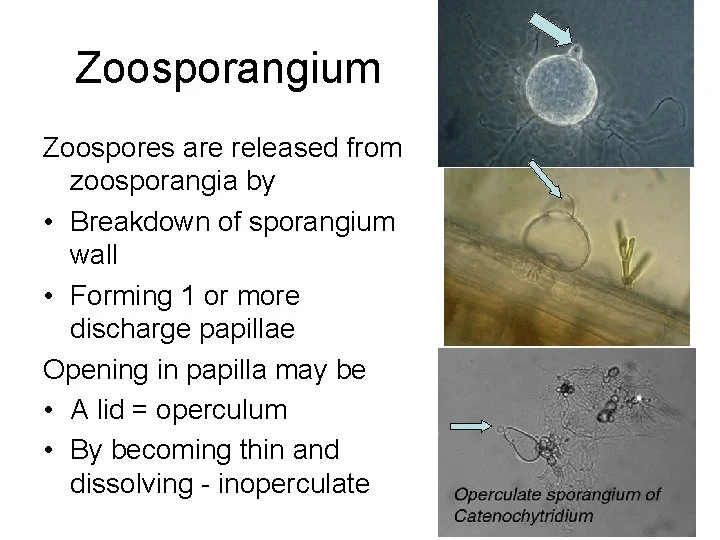An outline of the classification of fungi ( Krik et al., 2018)
Here the phyllum under three kingdom:
| Kingdom Fungi |
Kingdom Chromista |
Kingdom Protozoa |
| Chytridiomycota |
Hypochytridiomycota |
Protostelea |
| Neoallimastigomycota |
Labyrinthulomycota |
Myxogastrea |
| Blastocladiomycota |
Oomycota |
Dictyostelia |
| Zygomycota |
|
|
| Ascomycota |
|
|
| Glomeromycota |
|
|
| Microsporidia |
|
|
| Basidiomycota |
|
|
Lets talk about the each kingdom of fungi organism.
Characteristics of Kingdom Fungi/True Fungi
| Points |
Description |
| Nutrition |
Absorption mode |
| Cell wall |
Chitin , Beta Glucan |
| Somatic phase |
Unicelllular or filamentous |
| Flagella |
Only whiplash |
| Cristae |
Flattened cristae in mitochondria |
| Peroxisome , Golgi bodie |
Present |
Characteristics of Kingdom Chromista
| Points |
Description |
| Nutrition |
Absorption mode |
| Cell wall |
Cellulose |
| Somatic phase |
Unicelllular or filamentous |
| Flagella |
Tinsel type |
| Cristae |
Tubular cristae in mitochondria |
| Peroxisome , Golgi bodies |
Present |
In 18S rDNA Phylogenytic studies this fungi show closer genetic relatedness to brown algae and diatoms then to true fungi.
Characteristics of Kingdom Protozoa
| Points |
Description |
| Nutrition |
Ingestion mode , exception is seen in plant parasites showing absorption type of Nutrition |
| Cell wall |
No cell wall in somatic phase. Cellulosic, Chitinous spore wall |
| Somatic phase |
Plasmodial, Amoeboid |
| Flagella |
Spore germinate to produce 1-2 flagellated cell |
| Cristae |
Tubular cristae in mitochondria |
| Peroxisome , Golgi bodies |
|
Fungi/True Fungi in detail:
1) Chytridiomycetes:
| POINTS |
DESCRIPTION |
| Cell wall |
Chitin, Glucan |
| Vegetative thallus |
✔ Unicellular ✔ Aseptate ✔ Haploid (n) ✔ Holocarpic & Eucarpic - ✔ Monocentric ✔ Polycentric |
 |
| CHYTRIDIOMYCETES |
 |
| Chytridiomycetes veg. thallus |
Asexual reproduction in Chytridiomycetes:
| POINTS |
DESCRIPTION |
| Spore |
Zoospore |
| No. of flagella |
Uniflagellate |
| Flagella type |
Posteriorly whiplash |
Points on Zoosporangium:
| Point |
Description |
| Zoosporangium development |
1) from VEGETATIVE THALLUS(holo/eucarpic-rhizoids and rhizomycelium) 2) from PROSPORANGIUM 3) from HYPHA |
| Opening type |
Operculate or inoperculate |
| Papilla |
May or May not bear exit papilla |
| Apophysis |
May or May not present. Apophysis means holding structure of zoosporangium |
| Other |
May be meiosporangium or mitosporangium |
What is papilla, inoperculate, operculate?What is the difference between apophysis & zoosporangiophore?
 |
| papilla in zoosporangium |
Example of zoosporangium developed from different source & other features:
| Zoosporangium points |
Example |
| VEGETATIVE THALLUS |
- |
| PROSPORANGIUM |
Polyphagus euglinae |
| HYPHA |
Monoblepharis |
| Operculate sporangium |
Rhyzophydium |
| Inoperculate sporangium |
Chytriomyces, Chytridium |
| Sporangium with exit tube |
Olpidium |
| Sporangium bearing apophysis |
- |
| Mitosporangium and mitosporangium |
Allomyces |
Meiosporangium- Thick wall ,
pited due to presence of melanin.
will give rise to haploid spore , encysted , germinate then gametophytic thallus.
Mitosporangium- Thin , non pited , will give rise to sporophytic thallus.
EXCEPTION & IMPORTANT: MEIOSPORANGIA IS THE ASEXUAL STRUCTURE SHOWING MEIOSIS.Sexual reproduction in Chytridiomycetes:
| POINTS |
DESCRIPTION |
| Method |
Gametic copulation(iso,aniso,hetero), Gamatangial copulation, Somatogamy, Plasmogamy using copulation tube |
| Spore |
Oospore |
| Place of Karyogamy |
Zygote/Oospore |
| Sexual life cycle |
Haplobiontic haploid, Diplobiontic |
Different sexual reproduction with example:
| Sexual reproduction |
Example |
| Iso Gametic copulation |
Synchytrium,Olpidium |
| Aniso Gametic copulation |
Allomyces |
| Hetero Gametic copulation |
Monoblepharis |
| Gametangial copulation |
Rhizophydium |
| Somatogamy |
Chytriomyces |
| Plasmogamy using copulation tube |
Polyphagus |
Planoganetic/ heterogametic copulation lead to motile
zygote, then deflagellated and encysted to form non-motile
zygote or diploid sporophytic plant or thick walled resting
spore oospore.
Sexual cycle: Life cycle haplobiontic haploid or
Diplobiontic (Isomorphic or Anisomorphic or heterogamic
morphic alternation of generation)
Orders of Chytridiomycetes:
| Characters |
Chytridiales |
Blastocladiales |
Monoblepharidales |
| Veg. thallus; cell wall composition |
Unicellular holo or eucarpic (mono or polycentric; cell wall contain chitin |
Trunlike (without or with dichotomously with dichotomouslywith dichotomously or tree like branched); cell wall contain chitin |
Highly filamentous, foamy in appearance; cell wall contain cellulose |
| Zoospores shape |
Spherical or oval in shape |
Obpyriform or elongared |
Conicle |
| Zoospore movement |
Move by hopping |
Regular and even movement |
Regular and even movement |
| Zoospore nuclear cap |
- |
+ |
+ |
| Zoospore oil globule |
+ |
- |
+ |
| Zoospore germination |
Monopolar |
Bipolar |
Bipolar |
| Methods of plasmogamy |
Isoplanogametic copulation |
Anisoplanogametic copulation |
Heterogametic copulation |
| Sexual spore |
Diploid resting spore |
Diploid resting spore |
Diploid oospore |
Families under the order Chytridiales:
| Family |
Vegative thallus |
Sporangium |
Fungal genera |
| Olpidiaceae |
Unicellular holocarpic (single sporangium) endobiotic |
Inogerculate |
Olpidium |
| Synchytriaceae |
Unicellular holocarpic (sorus of sporangia) endobiotic |
Inogerculate |
Synchytrium |
| Phlyctidiaceae |
Epi or endobiotic; eucarpic Inoperculate monocentric |
Inogerculate |
Rhizophydium , Diplophlyctis |
| Rhizidiaceae |
Eucarpic monocentric, interbiotic, form pro-sporangium |
Inogerculate |
Polyphagus, Rhizophlyctis |
| Cladochytriaceae |
Eucarpic polycentric, have spindle or turbinate cell that forms thick walled resting spore |
Inogerculate |
Cladochytrium, Polychytrium |
| Physodermataceae |
Eucarpic monocentric epibiotic, eucarpic polycentric endobiotic, bear turbinate cell |
Inogerculate |
Physoderma, Urophlyctis |
| Chytidiaceae |
Eucarpic monocentric epibiotic, eucarpic polycentric endobiotic, bear turbinate cell |
Operculate |
Chytridium, Chytriomyces |
| Megachytriaceae |
Eucarpic polycentric |
Operculate |
Nowkowskiella, Megachytrium |
.
.
 |
| Chitrideomycetes |










